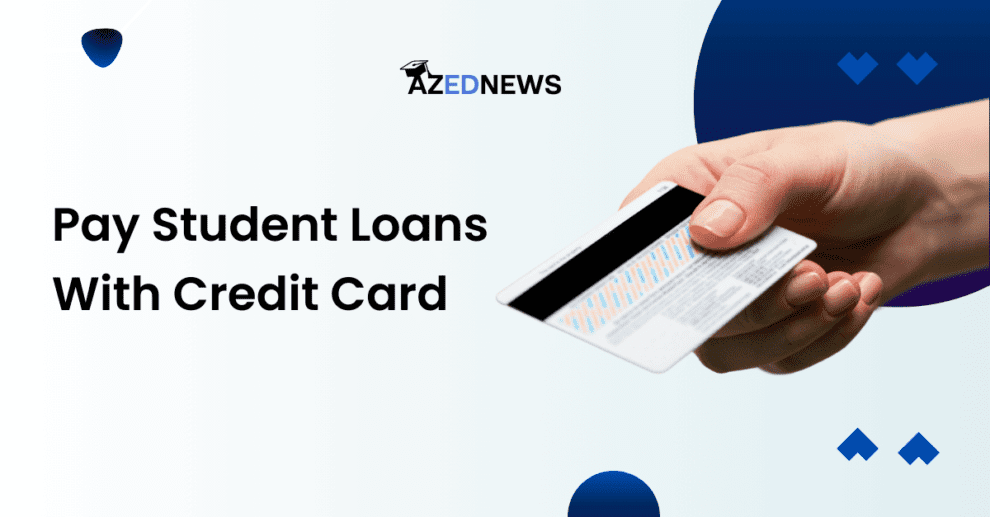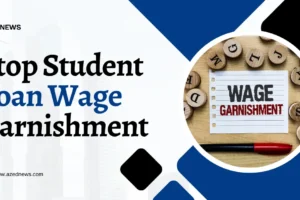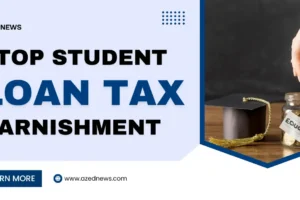Do you want to pay your student loans with a credit card? The good news is that, although not directly, but you can pay student loans with credit card now. In this article, you will learn in detail in which scenarios you can use a credit card to pay off your student loans.
Table of Contents
Under some circumstances, you can use a credit card to pay your student loans. Typically, credit cards are not accepted by student loan service providers. Processing costs are associated with every credit card transaction, and the party accepting the card as payment is responsible for paying them. Of course, lenders will not cover such costs in the same way retailers do!
Although you may be allowed to use your credit card to pay off private loans, you cannot use it directly to pay off federal student loans. Now, we’ll discuss ways you can pay student loans with credit card!
How You Can Pay Your Student Loan With a Credit Card?
As stated, you can’t use a credit card to pay off student loans directly. However, some credit card payment options allow you to pay student loans with credit card. Let’s check out each credit card payment option:
Use a Third-party Service
Despite their unfavorable reputation, middlemen can be beneficial in this situation of paying student loans with credit cards. When you pay for your student loans using a third-party website, you can charge your credit or debit card and let the recipient pay with their preferred method. You can use this method to pay for larger expenses that wouldn’t normally take a credit card.
With this option like a check or bank transfer, you have more control over your financial flow, and you can even earn points on bills you normally wouldn’t be able to. For a fee, payment providers like Plastiq can use credit cards to make loan payments on your behalf. When paying off your student loans with a card on Plastiq, be prepared to pay 2.9%.
Pay with a Convenience Check
If you want to take a more direct route and avoid paying third-party websites, consider a feature convenience check to pay student loans with credit card. It works similarly to a personal check, in that it lets you access the entire amount on your credit card and the payment is immediately paid to the recipient.
It works with any place that accepts regular checks and is a convenient way to bypass the credit card restrictions of most student loan providers. Because it doesn’t need to go through another service, it may also be processed more quickly. On your credit card, convenience checks are considered cash advances.
When you use convenience checks to pay student loans with credit card, interest is charged at the instant cash advance rate, and you will be charged a cash advance fee, typically between 3% to 5% of the check amount. Typically, that annual percentage rate is higher than the APR on your purchase or loan transfer.
Make a Transfer
Some credit card providers allow balance transfers for loan repayment. Still, it is important to confirm this with both the credit card issuers and the lender beforehand. Remember that balance transfers typically have a 3% to 5% fee associated with them. Before going ahead and choosing a financially wise option, make sure you are aware of all the terms and charges related to this option.
Look for Some of these Features in Your Credit Card
When selecting a credit card to pay student loans with credit card, prioritize features like low-interest rates, no annual fees, and rewards programs that fit your spending habits. Additionally, check out flexible payment options and consider cards with 0% introductory APR offers to save on interest fees. Here’s an overview of these features:
1. 0% APR
You may be able to save money on interest if there’s a balance transfer deal or a 0% introductory APR. In certain circumstances, settling your entire student loan debt via a balance transfer to a 0% card can potentially help you save money. However, if you are struggling financially and are just looking for a means to pay your bills, this is not the path for you.
At the very least, you’ll avoid paying interest in the short term if you pay with a credit card that offers an introductory 0% APR period. Nevertheless, you will be responsible for the processing costs. Additionally, you will be responsible for excessive financing costs if you are unable to pay the amount by the end of the 0% period.
2. High Credit Limit
Make sure you have enough credit available to cover your student loan payments without exceeding your credit limit. It’s best to avoid using more than 30% of your credit limit on any one card to maximize your FICO credit score.
3. Rewards
Consider looking for a credit card with a substantial sign-up bonus and a generous reward rate of 1.5% or 2% on all purchases. To pay student loans with credit card may seem tempting for the rewards, but be careful. The processing fee involved may exceed the value of any points or cashback earned from the $500 spent.
Is It a Good Idea to Pay Off Student Loans with a Credit Card?
In general, to pay student loans with credit card is not a good idea. The interest rates on credit cards are often higher than those on student loans, increasing the total debt. Additionally, credit cards may not have the same flexible repayment plans and affordable interest rates as student loan providers.
Transferring student loan debt to credit cards can lead to a vicious cycle of high-interest debt. To manage the loan better, it is advisable to look at alternative strategies including negotiating better terms with lenders or refinancing the student loan at a lower interest rate.
Why It’s a Bad Idea to Pay Student Loans Using a Credit Card?
Although you can technically use a credit card to pay off your student loans, some factors make paying student loans with a credit card a bad idea. Those factors are as follows:
1. Higher Interest Rates
It is difficult to find a credit card with a lower interest rate than student loans. Even if you can reduce your monthly credit card payments by choosing the lowest payment plan, you will eventually have to pay more in interest. Even though there is a 0% APR incentive available to you for balance transfer checks, this is only temporary.
2. Fees
Choosing an intermediary like Plastiq or using a balance transfer check usually incurs a transaction fee. On the other hand, standard student loan payments have no additional fees. As a result, it is generally not advisable to pay student loans with credit card.
3. Low Margin
It may be tempting to consider using a credit card to pay off student loans for additional rewards. However, credit card companies typically don’t offer rewards on balance transfer checks. Additionally, the transaction fees associated with using an intermediary are likely to outweigh any benefits received from cash back, points, or miles.
4. Probability of Losing Protection
Federal student loans provide protection and relief to borrowers facing financial hardship. But, if you adopt the method to pay student loan with credit card, you will be deprived of those benefits. As a result, you lose potential risk and safety net. Therefore, you should consider the long-term consequences of making such a financial decision.
Alternative Ways to Pay Student Loans With Credit Card
If you’re having trouble paying off your student loans, look at other options before turning to credit cards. Check for loan consolidation, income-driven repayment arrangements, and applications for moratoriums. By reducing your reliance on credit cards, these options can improve your financial situation management. Let’s explain each option:
Income-driven Repayment
Federal student loan borrowers have the option of an income-driven repayment plan, which offers flexibility by adjusting monthly payments according to their income and family size. The plan reduces financial pressure, providing a personalized approach to loan repayment. The income-driven repayment plan aims to make repayments more manageable for individuals, ensuring that the financial burden of student loans is commensurate with their current financial circumstances.
Consolidation
Federal student loan borrowers may explore consolidation as an option. This process merges multiple student loans into a single monthly bill with a fixed interest rate. Consolidation offers the convenience of streamlined payments and the possibility of accessing a new payment plan with lower monthly obligations.
By simplifying the repayment structure and potentially reducing payments, consolidation aims to increase the manageability of student loans for borrowers, facilitating a more structured and financially viable approach to repayment.
Refinancing
Exploring private student loan refinancing offers the possibility of a lower interest rate, lower payments, or a combination of both benefits. This process allows borrowers to consolidate private loans into a new single loan or merge private and federal loans.
However, it is important to note that choosing this may result in the federal loan security being forfeited. While refinancing offers financial benefits, borrowers should weigh the benefits against the disadvantages of federal safeguards before deciding on this approach.
Deferment or Forbearance
Deferment and forbearance provide temporary relief from student loan payments during financial stress. In moratorium, specific federal loans remain interest-free, providing relief to borrowers. In contrast, forbearance involves interest accumulation, increasing the overall repayment burden.
Breaks in private student loan payments depend on individual lenders, who often allow breaks but with continued interest accumulation. Considering these two options requires careful consideration of the impact on long-term financial obligations.
List of 10 Best Credit Card Companies for Students in the USA
- Discover
- American Express ( Check our detailed article on American Express Student Credit Cards)
- Capital One
- Barclays
- Chase
- Mastercard
- Visa
- Bank of America
- PNC
- Citizens Bank
FAQs.
1. Can I use my credit card to pay off my student loan?
While some loan servicers may accept credit card payments, it’s not a widely adopted practice. Typically, student loan service providers do not offer credit card payments. Federal regulations often prohibit this practice.
The inherent processing fees associated with credit card transactions deter lenders, as lenders accepting credit card payments must cover these fees.
2. Can loans be paid with a credit card?
If allowed by your lender, and you have enough credit limit, you can use a credit card to partially pay off your student, home, or car loans. It’s worth noting that federal student loan issuers, under Treasury Department regulations, cannot accept credit card payments. So, always check with your specific lender to understand their policies regarding credit card payments for loans.
3. Are there benefits to paying student loans with a credit card?
To pay student loans with a credit card comes with some benefits like reward points. However, it’s important to carefully consider these benefits in relation to potential fees and interest rates. Moreover, it’s worth noting that not all credit card companies categorize student loan payments as eligible for rewards.
4. Can I transfer money from my credit card to a bank account?
Although it is not advised, it is still possible to use a credit card to create a cash advance or balance transfer check that deposits money into a bank account. This is because the high-interest rates and expensive upfront costs associated with cash advances make them risky. If the balance transfer is not done properly, it may result in additional debt.
5. Can I pay all EMI on my credit card at once?
All EMIs can be paid in one go through credit cards. However, credit card companies often assess closing charges from the person who pays his EMI in advance. Additionally, since the loan will be repaid in full, future interest must be deducted from the principal amount.
Conclusion
It may be tempting to pay student loans with credit card, but you should consider it carefully. The associated high interest rates, potential damage to credit scores, and the risk of further debt accumulation outweigh the convenience factor.
Making sound financial decisions is paramount, leading individuals to consider alternative repayment approaches. It is important to prioritize long-term financial well-being. So, it is advisable to thoughtfully evaluate the potential consequences before adopting unconventional methods to deal with student loan debt.












Add Comment